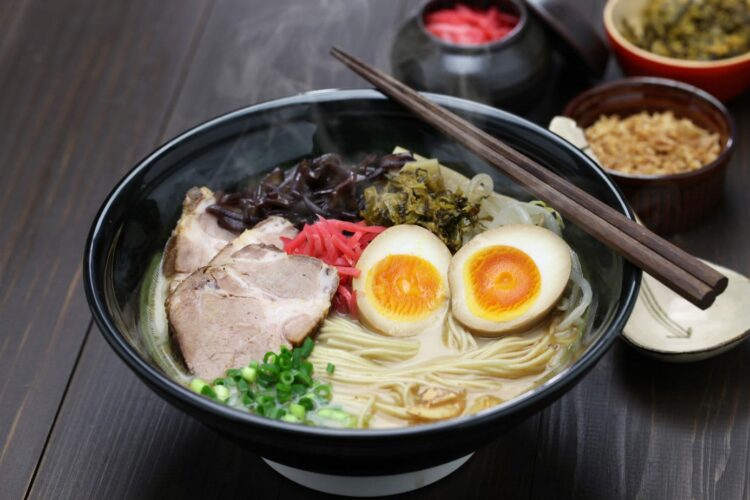What is ramen?
Ramen is a dish from traditional Japanese cuisine, essentially composed of wheat noodles, broth, tare (sauce), vegetables, and meat.
With its wide assortment of toppings, ramen is a “chameleon” dish that can be made into hundreds of recipes. From thin and curly noodles to thick and straight ones, from beef or pork to fish, not to mention the various vegetables and/or condiments, you’re sure to be able to compose a dish to your liking.
Most often, ramen is garnished with Japanese marinated eggs, kamaboko such as narutomaki, chopped green onions, bamboo slices, dried seaweed, corn… Plenty of inspiration! Preferably consumed Japanese-style, with chopsticks and a spoon.

Types of ramen
There are 9 main categories of ramen:
- Shoyu ramen is served in a chicken-based broth with soy sauce.
- Shio ramen is also a chicken broth, but salted. It’s certainly the lightest of the broths.
- Miso ramen, the noodles are thicker and more substantial and marinate in a richer miso-based broth.
- Tonkotsu ramen. Made from a richer broth, obtained from simmered pork bones.
- Le ramen tantanmen: le ramen tantanmen est un descendant du chinois dan dan mian du Sichuan. Un coup d’œil à son aspect orange-rougeâtre vous dira directement qu’il s’agit d’un ramen épicé. D’autres caractéristiques notables des tantanmen incluent l’utilisation d’huile de sésame et la petite montagne de viande hachée qui la recouvre.
- Tsukemen ramen: Tsukemen (dipping noodles) is a type of ramen where the noodles and soup are served separately. To enjoy this dish, you must dip the noodles in the thick soup before eating. Tsukemen noodles are often chewy and are served cold or hot depending on the restaurant. Its broth comes in different variants, most being thick, sauce-like and very rich in flavors.
- Curry ramen: Curry ramen is essentially “just” ramen noodles with a curry sauce. The noodles are often thicker than other types of ramen. The curry used ranges from sweet to spicy, with the former being more common in Japan.
- Maze soba: Maze (mixed) soba gets its name from the fact that you have to mix the topping with the noodles before eating. Unlike most types of ramen, maze soba is served dry. In some restaurants, maze soba may also be called abura soba (油 そ ば) or abura ramen (油 ラ ー メ ン). “Abura” means oil, which also refers to the flavored oil used in the preparation
- Cold ramen: A summer-exclusive dish, cold ramen is commonly called hiyashi chuka (冷やし中華). It is served cold, with or without broth, and accompanied by citrus fruits like lime, lemon, or yuzu to add a refreshing taste. Eating cold ramen will make you forget the oppressive heat of summer in Japan.
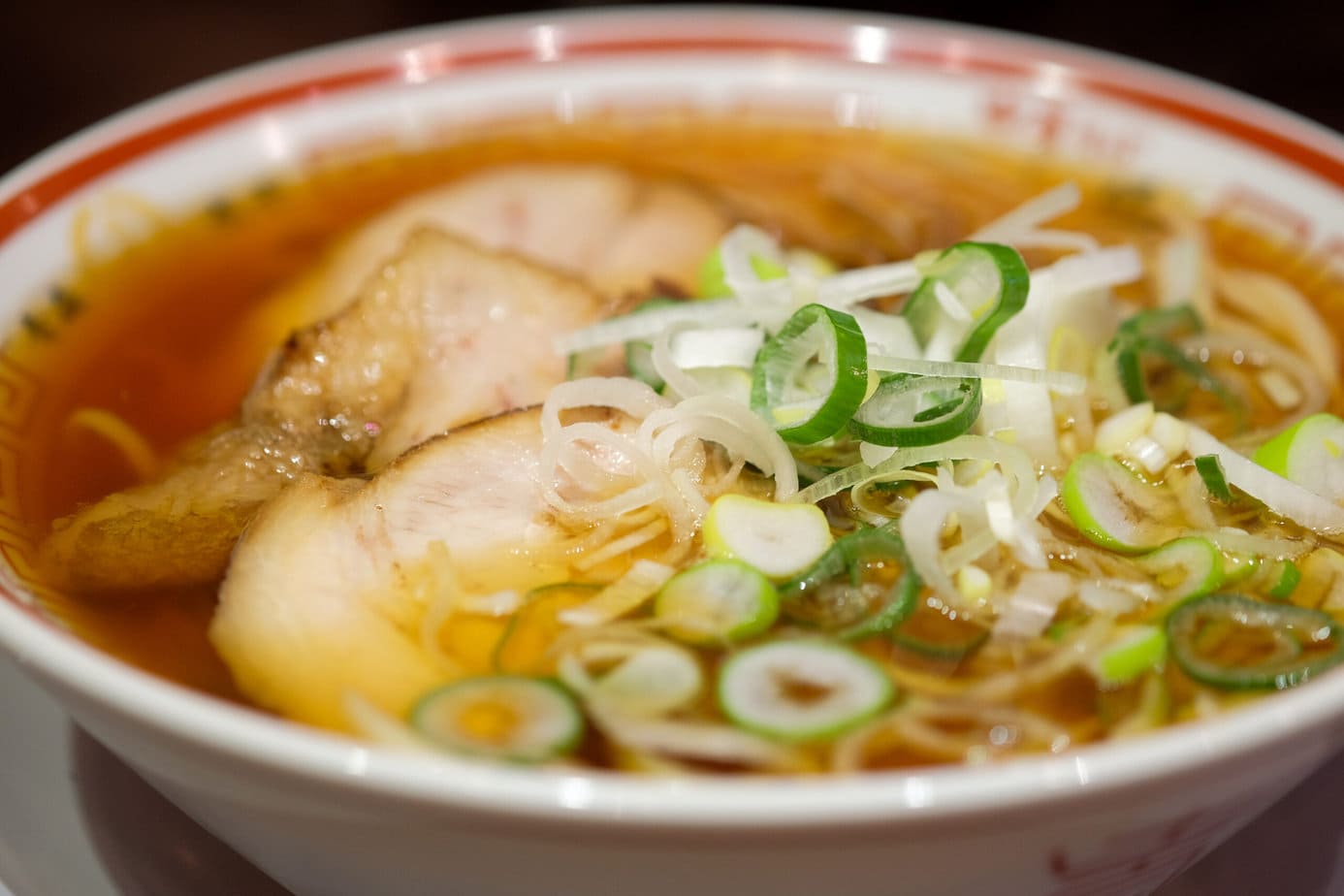
Types of ramen broths
There are two main types:
The broth called Chintan (清湯、チンタン): Chintan means “clear soup”, and the term is derived from the Chinese language. Chintan refers to types of ramen with a clear broth base, and they tend to have a lighter and softer taste. The types of ramen classified as chintan are shoyu ramen and shio ramen.
The broth called Paitan Paitan (白湯、パイタン): Paitan, a term also derived from the Chinese language, means “white soup”. Paitan refers to types of ramen that have a cloudy, milky, and opaque broth – they don’t necessarily have to be white in color. The soup of a tonkotsu ramen is an example of paitan.
Origins of ramen
While ramen is now a flagship dish of Japanese cuisine, this wasn’t always the case. In its beginnings, it was indeed a Chinese recipe.
It’s considered that from 1635, Japan closed all its borders and refused any foreign influence, except in Nagasaki. This was an opportunity for the whole world to transmit a bit of their culture to Japan. Thus, the Chinese brought their soups and noodles (which were then called champon, a noodle soup originating from Nagasaki).
Ramen was actually only born from the fusion of the Chinese specialty with Japanese cuisine.
And Japanese richness hasn’t finished surprising you: each region of Japan has its own designated ramen dish that represents its climate and local environment. Today, ramen is seducing more and more countries. It’s therefore not uncommon to find several small spots near you where you can enjoy it.
Ramen noodles vs udon noodles
Ramen noodles and udon noodles are quite similar in terms of taste. Small subtlety: udon noodles are between 3 and 4.5 millimeters wide compared to 1.5 millimeters for ramen noodles.
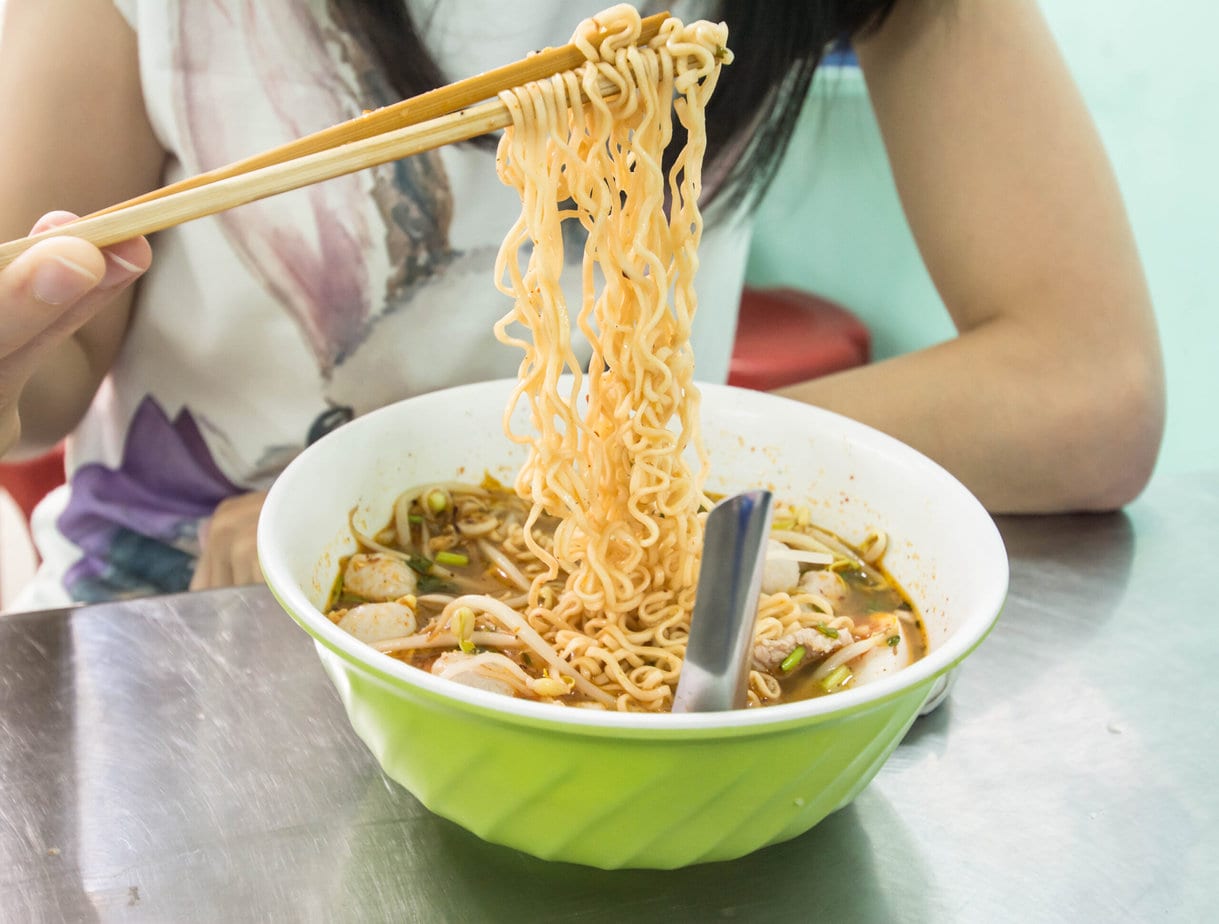
All noodles are presumably made with wheat flour, salt, water, and kansui (an alkaline mineral), which gives them their characteristic elasticity and yellow color. Unlike udon noodles which do not contain kansui. They are therefore white and stiff, not yellow and curly. These noodles are traditionally served with a lighter broth.
How to cook ramen noodles?
We often think of ramen as an instant dish, convenient and simple to cook. And it is indeed a dish that is not only very adaptable but also quick to prepare. There is a wide range of instant noodles available on the market, almost ready to be consumed.
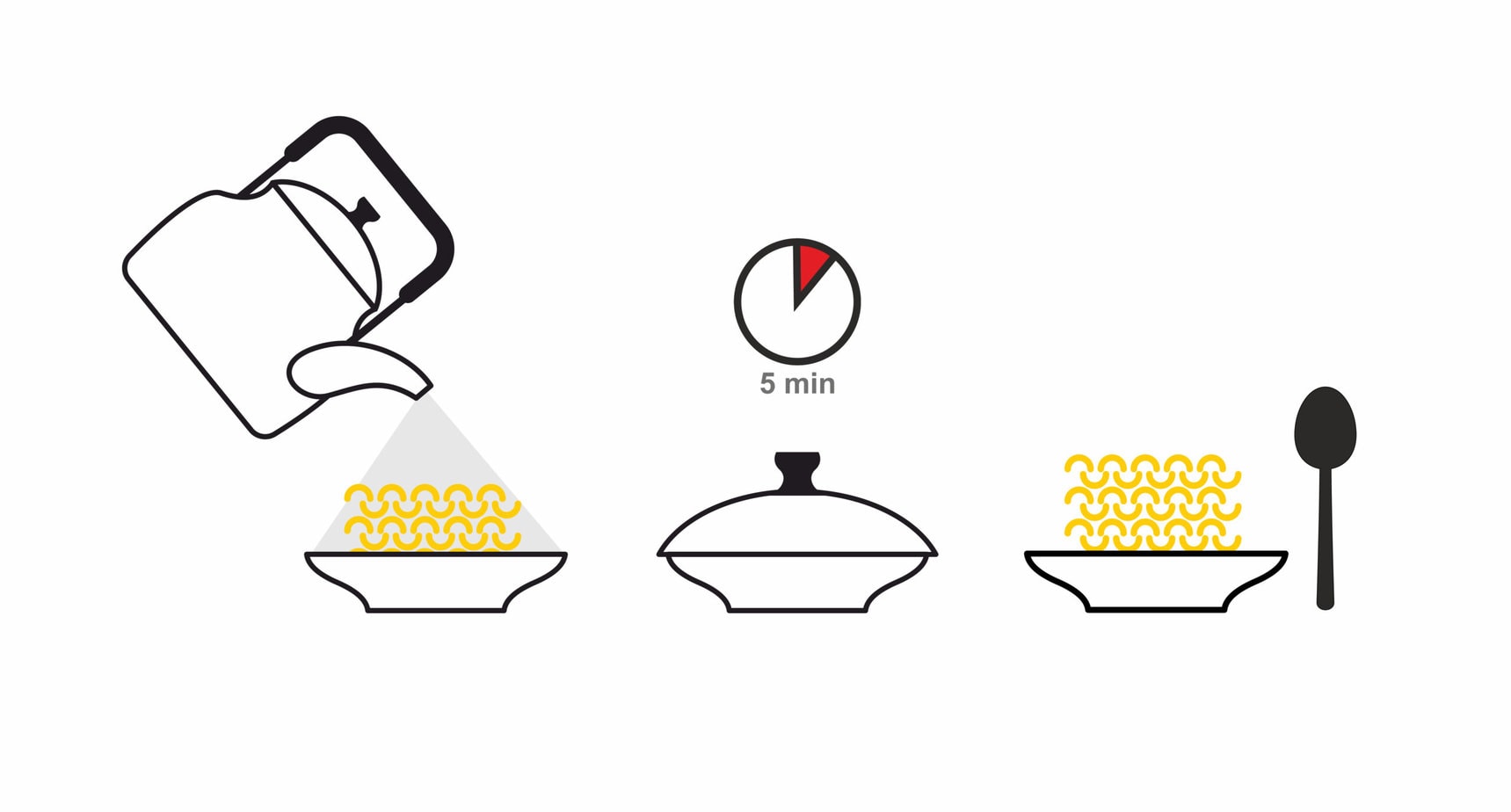
You just need to pour water into your pot, follow the provided cooking instructions, and your dish will be quickly ready. Nevertheless, it is entirely possible to find fresh noodles in Japanese grocery stores.
And if you aspire to prepare your own noodles, many sites are full of information to guide you through this process. Fresh noodles generally simmer for 1 to 2 minutes before being drained and added to your broth. A dish within everyone’s reach!
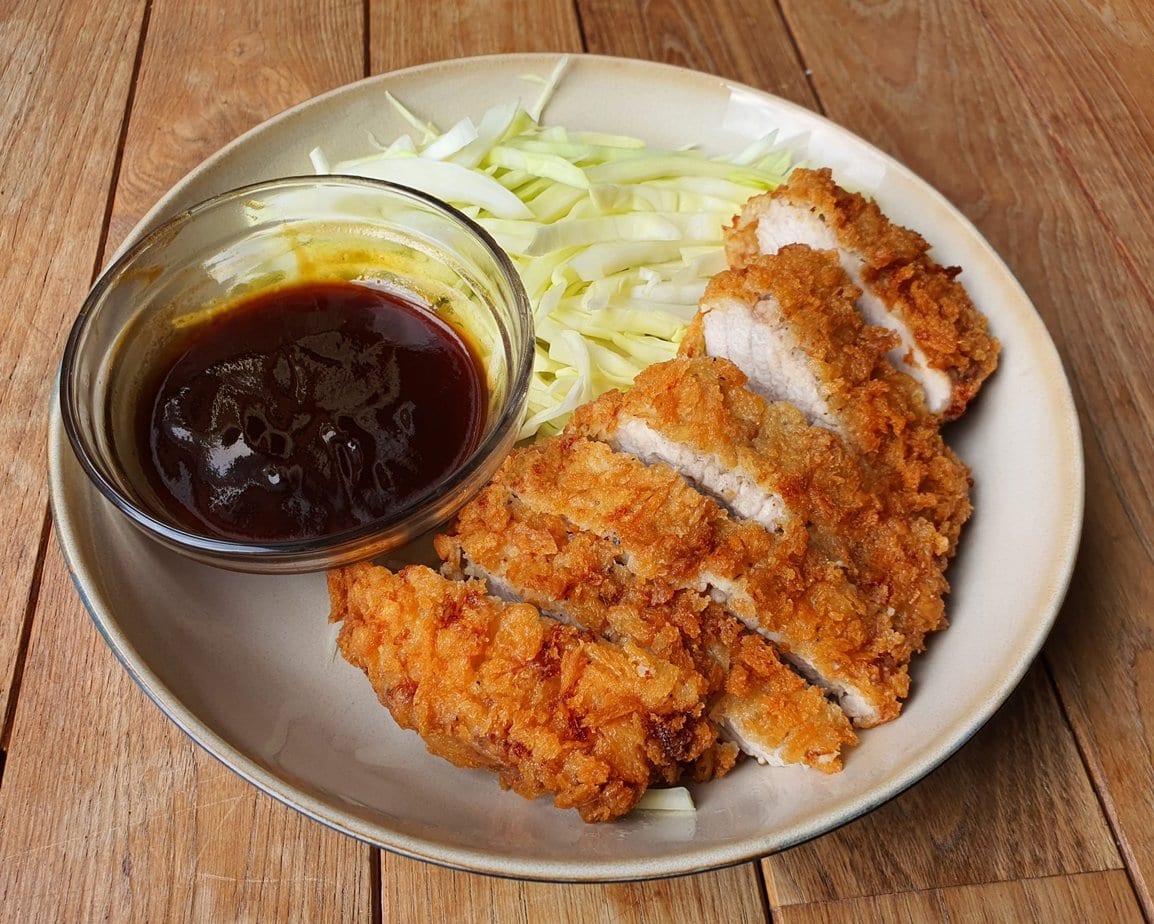
How to replace ramen noodles?
Can’t find dried ramen noodles? It’s not a problem. You can very well use somen noodles, another Japanese variety, or rice noodles. If you can’t find any of these in your drawers, Italian vermicelli can also substitute traditional ramen noodles.
How to make homemade ramen?
This article is not intended to teach you from A to Z how to make ramen (better) than at a restaurant. But rather, to introduce you to it, and this will also be the case with the recipe below. The broth is simple and easy to prepare with very accessible ingredients, but it has a lot of good flavor.
Anyone can do it! Pork belly is very fatty but it gives the soup a wonderful taste, and the cooked pork itself serves as a topping. Simply cool the soup and remove any excess fat from the soup.
If you want, replace the pork in this recipe with my chashu pork which is a traditional topping for ramen
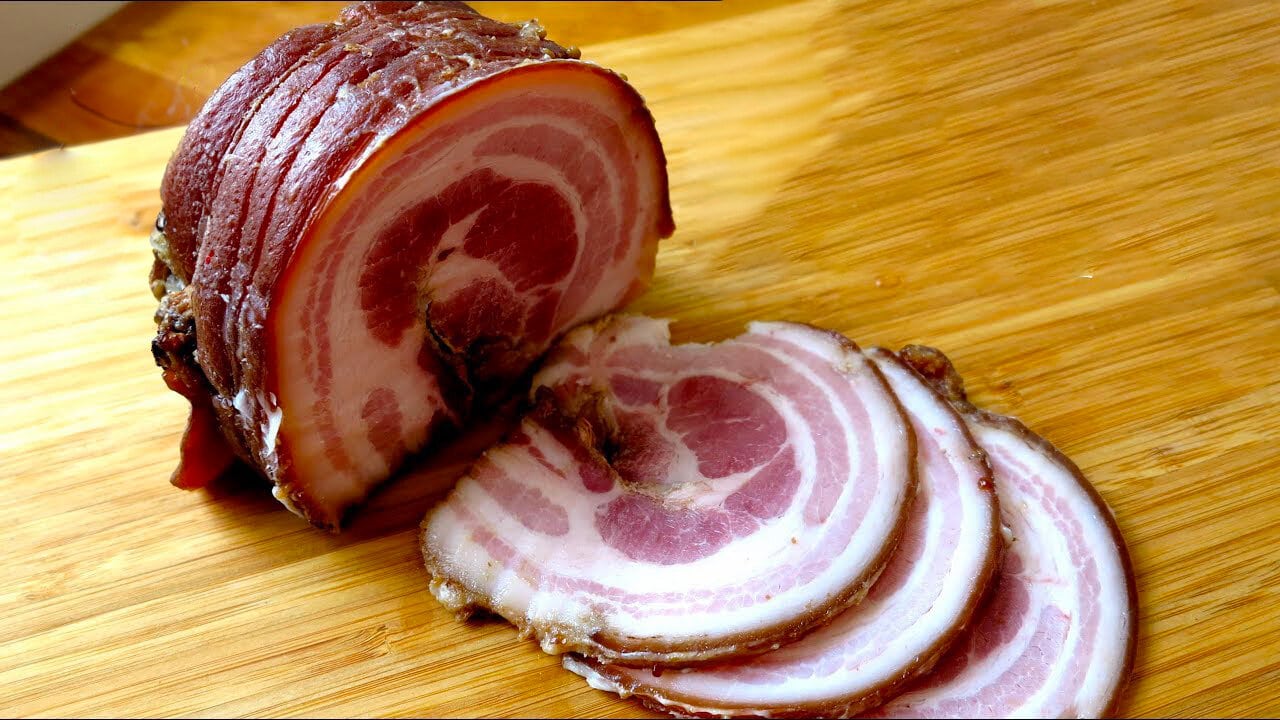
As mentioned above, there could be many flavor combinations for broths. So, if you want to experiment with different ingredients, go ahead. I hope you can find the Ramen taste that you love!
How to cook ingredients for Ramen
Here is a generalized table showing the cooking time for each ingredient to correctly extract the gelatin


Authentic Japanese Shoyu Ramen
Ingredients
Salted pork
- 450 g pork belly whole, not cut
- 2 teaspoons salt
Bouillon
- 1.5 liter of water
- 30 g of sliced ginger
- 3 cloves of peeled garlic
- 1 bunch of green onions
- 4 tablespoons light soy sauce
- 3 tablespoons of sake
- 1 teaspoon salt
- 1 tablespoon sesame oil
Noodles
- 4 “bundles” of dried ramen noodles
Trim
- Soft-boiled egg cut in half
- Briefly blanched bean sprouts
- Finely chopped green onions
Instructions
- Rub the pork with salt and let it rest overnight in the fridge.
- Put the water, ginger root, garlic, green onions, and salted pork in a pot and bring to a boil over high heat.
- Remove the scum and other impurities from the surface. Then cover, reduce to low heat, and let simmer for 1.5 to 2 hours.
- Let the broth and pork cool completely in the pot. Strain and keep the broth and pork separate.
- Let the broth cool in the refrigerator for at least a few hours or overnight, then remove the solidified fat. Also keep the cooked pork in the refrigerator so you can slice it easily later.
- Also prepare the rest of the toppings (soft-boiled eggs, blanched bean sprouts, chopped green onions) before preparing the broth and noodles. Once the noodles are cooked, you’ll need to add the soup and toppings right away, otherwise the noodles will become too soft, so you won’t have time to prepare the toppings.
- Bring the broth to a boil and add soy sauce, sake, salt, and sesame oil. Let simmer on very low heat until the noodles are ready.
- Cook the dried noodles according to the package instructions. Just before the noodles are cooked, pour the broth into serving bowls.
- Drain the noodles and immediately distribute them into the serving bowls.
- Garnish with soft-boiled egg, bean sprouts, green onions, and pork slices.
Notes
Or soak the soft-boiled eggs in a soy sauce-based sauce to make Ajitama.
